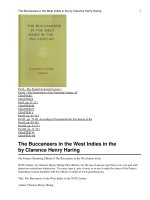Regional diversity in the nineteenth century
Bạn đang xem bản rút gọn của tài liệu. Xem và tải ngay bản đầy đủ của tài liệu tại đây (4.04 MB, 29 trang )
P1: RNK
0521864381c08 CUNY780B-African 978 0 521 68297 8 May 15, 2007 16:0
8
Regional diversity in the nineteenth century
even where the atlantic slave trade had not compounded the
difficulties, underpopulation had retarded Africa’s development and obstruc-
ted attempts to overcome political segmentation by creating enduring states.
Between the fifteenth and nineteenth centuries almost every part of the
continent was drawn into a world economy dominated by Europe and
apolitical order dominated by the growing use of firearms. These both
threatened African peoples and gave them new techniques and opportunities
to overcome segmentation, techniques that supplemented ancient strategies
and new devices of African invention. Ultimately most attempts to enlarge
the scale of economic organisation and political loyalty in nineteenth-century
Africa failed, partly because European aggression overwhelmed them, but also
because they did not meet the underlying problem of underpopulation, often
rather compounding it by the demands they placed on existing populations.
Beneath the surface, however, more profound changes took place. For the
first time, certain regions escaped ancient constraints and embarked on rapid
population growth. Others, by contrast, experienced demographic stagnation
or decline comparable to Angola’s. This regional diversity – the lack of an
overall continental trend – was a major feature of nineteenth-century Africa
and makes it necessary to treat each region in turn: first the north, then the
Islamic west, the south, and finally the east.
northern africa
The incorporation of North Africa (excluding Morocco) into the Ottoman
empire began in 1517,when Turkish musketeers defeated Egypt’s outdated
Mamluk cavalry in twenty minutes. Further west, Turkish privateers con-
tested the Maghribian coastline with local rulers and Iberian invaders until
an Ottoman force took Tunis in 1574 and made it a provincial capital, along
with Tripoli and Algiers. During the next two centuries, control from Istanbul
weakened to the advantage of provincial forces. In Egypt the army so overawed
the governors that they turned for support to the surviving Mamluks, whose
leaders (known as beys)regained predominance in the eighteenth century. In
164
P1: RNK
0521864381c08 CUNY780B-African 978 0 521 68297 8 May 15, 2007 16:0
Regional diversity in the nineteenth century 165
9.Regional diversity in the nineteenth century.
P1: RNK
0521864381c08 CUNY780B-African 978 0 521 68297 8 May 15, 2007 16:0
166 africans: the history of a continent
Tunis and Tripoli, where Ottoman garrisons were recruited from the soldiers’
children by local women, military commanders founded semi-independent
dynasties in Tunis in 1705 and Tripoli in 1711.Inthe frontier province of Algiers,
by contrast, the soldiers remained more alien, electing an officer as dey and gov-
erning the hinterland by using favoured tribes to extract taxes from the others.
All these North African societies under Ottoman rule weresegmentary, either
in the narrow sense that nomads belonged to autonomous tribes subdivided
into clans and lineages, or in the broader sense that society divided into peasant
villages or specialised, self-regulating, corporate groups like the 240guilds and
100 wards of late eighteenth-century Cairo. Below the military noblemen and
merchants who dominated capital cities, most townsmen were small traders
and craftsmen – Cairo’s average workshop had only three or four producers –
while the lowest work fell to day-labourers and the black slaves who consti-
tuted 4 or 5 percent of urban populations. Most countrymen were peasant
farmers controlling their own land, using a technology little changed since the
early Islamic centuries, and supporting the ruling class through taxation. Rich
peasants produced rice or sugar in Egypt or olive oil in the prosperous Sahel
of eastern Tunisia. Poor sharecroppers – khamanisa,keeping only one-fifth of
their produce – cultivated estates on the coastal plains. Nomadic pastoralists
in the hinterland paid taxes only to military expeditions.
The Ottoman states enjoyed their greatest prosperity during the seventeenth
century. Tunisia remainedprosperous during the eighteenth century and Egyp-
tians were probably as rich on average as Frenchmen in 1800, but by then the
whole region was falling under European economic predominance. Industry
was constrained by guild control, which prevented concentration ofproduction
into larger units permitting mechanisation. Although late eighteenth-century
Egyptexported almost as much cloth as it imported, the imports came from
Europe, whereas the exports went largely to the rest of North Africa. Egypt
also took almost all its metals from Europe as well as most of its currency,
the shipping that conducted its Mediterranean trade, and some of the foreign
merchants who increasingly dominated its external commerce. ‘In a certain
measure,’ Andr
´
eRaymond has written, ‘it is already a commerce of “colo-
nial” type.’
1
Tunisia’s increasing dependence on olive-oil exports had similar
implications.
Behind this relative decline lay the stagnation of North Africa’s population.
In 1800 Egyptmay have contained between four million and five million peo-
ple, probably equal to its Ptolemaic numbers. Tunisia probably had only one or
one-and-a-half million. Most estimates for Algeria suggest three million in 1830,
although some claim five million.
2
The chief reason for demographic stagna-
tion was plague, which had remained endemic throughout North Africa since
the Black Death (chiefly as an urban disease, thanks to regular contacts with
the central Ottoman lands), whereas plague had disappeared from northern
P1: RNK
0521864381c08 CUNY780B-African 978 0 521 68297 8 May 15, 2007 16:0
Regional diversity in the nineteenth century 167
Europe by the eighteenth century. Algeria suffered five plague epidemics dur-
ing the eighteenth century alone; Egypt and Tunisia, three. Contemporary
mortality figures are unreliable, but the epidemic of 1784–5 was said to have
killed one of every three or six people in Tunisia. This was added to endemic
disease, the recurrent slaughter of infants by smallpox, and famine, although
famine was largely absent during the eighteenth century until its disastrous last
quarter.
This picture of relative economic decline and political instability rooted
in recurrent demographic crisis was equally true of Morocco, which escaped
Ottoman control by adopting Ottoman military innovations. First, Ahmad
al-Mansur (1578–1603) used mercenary musketeers to free the country from
Turkish and Christian threats. Then Mawlay Ismail (1672–1727)created an
army of black slaves that temporarily reunited most of Morocco. After his
death, however, the army only added to the kingdom’s powerful segmentary
tendencies. Declining towns and foreign trade weakened the monarchy’s chief
supports. More than half the population were Berber highlanders who despised
the state’s largely unpaid administration and respected only military force or the
king’s spiritual authority. The monarchy’s religious status denied it the freedom
of action enjoyed by more secular Ottoman rulers, exposing it to denunciation
by the ulama (clerics) if it demanded non-Koranic taxes. Behind this frailty of
authority lay demographic weakness. Between 1500 and 1800,Moroccosuffered
at least ten plague epidemics, which were most destructive in the towns and
surrounding plains where royal power centred. Famine was especially serious
during the seventeenth century, that of 1661 –2 in Fes belonging to the rare
category in which, as a chronicler wrote, ‘Those who died there among the
great and the rich – and they were numerous – died of hunger like the poor.’
3
Morocco’s population in 1800 may have been three million or four million,
barely more than in 1500.
4
NorthAfrica’s demographic crisis culminated during the first third of the
nineteenth century. In 1818–20 the Maghrib suffered its last great plague epi-
demic. Egypt experienced one more, in 1835, thought tohave killed 200,000 peo-
ple. Thereafter plague virtually disappeared, as mysteriously as it had already
deserted Europe. But other disastersintervened. Tunisia suffered an acuteagrar-
ian crisis, largely due to drought, which roughly halved the cultivated area of
state domain between the mid-eighteenth century and the 1820s. In 1831 Egypt
suffered its first attack of Asiatic cholera, carried by pilgrims using the faster
transport now available from Mecca. It allegedly killed 150,000 Egyptians. Four
years later the same pandemic reached the Maghrib, the first of five to afflict
nineteenth-century North Africa. Although a hideous disease that killed about
half of those contracting it, cholera caused fewer deaths than plague, except
during the 1830sorwhen associated with famine. It probably hindered popu-
lation recovery rather than causing absolute decline. But it came immediately
P1: RNK
0521864381c08 CUNY780B-African 978 0 521 68297 8 May 15, 2007 16:0
168 africans: the history of a continent
after plague, with no interval for demographic growth such as Europe and
China had enjoyed.
Paradoxically, however, it was during this period of disaster that Egypt took
the first steps towards the rapid demographic growth that has dominated mod-
ern African history. Elements of a new Egypt emerged in the later eighteenth
century. Mamluk beys gained predominance over Ottoman forces, especially
under Ali Bey (1760–72), who made himself almost independent ruler of an
increasingly Egyptian state. Expanded trade with Europe contributed to eco-
nomic crisis but also encouraged commercial agriculture, weakened guild insti-
tutions, and bred a coalition of artisans and radical clerics who became an
important political force in Cairo. French invasion in 1798,designed to secure
grain supplies and threaten Britain’s position in India, stimulated Egyptian
patriotism, destroyed the Mamluk-dominated military and governmental sys-
tem, and provided new models of military and administrative organisation to
supplement those which the Ottoman Empire itself had begun to adopt during
the 1780s. The first beneficiary was Muhammad Ali (1805–48), an officer in the
Ottoman army that recaptured Egypt in 1801.Inthe ensuing power struggle, he
supplanted the Ottoman governor by winning popular support in Cairo, only
subsequently to exclude these supporters from power. Muhammad Ali was an
Ottoman autocrat seeking to create a dynasty with maximum independence
from Istanbul. Illiterate to the age of 47,suspicious and superstitious, his pen-
etrating mind and Ottoman receptivity to military innovation convinced him
that a modern army needed not merely guns but a supporting industrial and
technical infrastructure. He recruited his army initially from black slaves and,
after 1823,fromEgyptian peasants conscripted for life. It numbered 200,000
at its peak and cost 60 percent of state expenditure. To finance it he abolished
all existing claims to revenue from land, collected tax directly from peasant
villages, and multiplied the proceeds six times during his first sixteen years.
From 1821 he compelled peasants to grow long-staple cotton as a taxable crop.
Irrigation works increased the cultivable area by 37 percent between 1805 and
1863.The state bought and sold all cotton, craft products, and many other
commodities. Muhammad Ali established industrial enterprises – especially
textiles, shipbuilding, and armaments – employing European technology, usu-
ally driven by animal power. Egypt’s spinning output per head became the
fifth largest in the world.
5
The need to import iron, coal, technology, and
skills was an obstacle to industrialisation. Assets were cheap cotton and labour,
cheap and ample food, excellent transport, and relatively high levels of average
wealth. To administer his programme, Muhammad Ali created a patrimonial
bureaucracy staffed by Turks in the upper ranks and Egyptians in the lower, all
holding military ranks. He founded primary and technical schools for a peak
of ten thousand students, sent some five hundred Egyptians for training in
Europe, but restricted education to state needs. This attempt to create the first
P1: RNK
0521864381c08 CUNY780B-African 978 0 521 68297 8 May 15, 2007 16:0
Regional diversity in the nineteenth century 169
industrial state outside Europe may never have been feasible in a country of
only five million people, compared with sixteen million in the United Kingdom
in 1801 and perhaps thirty million in Japan when it began to modernise in 1868.
But the question was never tested, for the British so feared that Muhammad Ali
might threaten their power inAsia that in 1838–41 they compelled him to reduce
his army to eighteen thousand men and abolish the commercial monopolies
that excluded European manufactures from Egyptian markets. Unprotected,
Egypt’s industries collapsed. By 1849 only two factories remained. The country
became more exclusively agricultural and dependent than it had been in the
eighteenth century.
Yetone lasting achievement of Muhammad Ali’s reign was demographic
growth, which has continued to this day. In 1800 Egypt probably had between
four million and five million people. A census in 1897 showed 9,734,405.
6
The
initial reason for growth was probably the disappearance of plague after 1835.
Cholera caused less mortality. The government’s main contributions were to
foster vaccination against smallpox – by 1850 Egypthad morethan 2,500 barber-
vaccinators immunising 80,000 children a year – and to create, from 1836,a
provincial health service. Other contributions were Muhammad Ali’s success
in ending internal warfare, the expansion of permanent irrigation, and perhaps
the adoption of maize during the eighteenth century. Population growth was
due to lower death rates, with no known changes in fertility. It is noteworthy
that Africa’s modern population growth began in its first state with a modern
government.
Under Muhammad Ali’s descendants, Egypt was wide open to European
economic penetration. By 1876 more than 100,000 Europeans lived there. They
profited from the cotton crop, which multiplied roughly ten times between
Muhammad Ali’s death and the early 1880s, occupying enough land to cause
Egypt to import grain from 1864.Totransport the cotton, some 1,750 kilome-
tres of railway were built between 1852 and 1879.The Suez Canal opened to
shipping in 1869.Aliberal economic strategy fostered private land-ownership.
By 1884 the royal family, notables, officials, and Europeans owned some 48
percent of cultivated land, although even large estates were generally farmed in
small tenant plots. A rural elite of village sheikhs and notables expanded, as did
a landless class whose availability for urban labour ended slavery. Cairo’s pop-
ulation doubled between 1850 and 1900. Plans to transform the city on Parisian
lines were largely frustrated, but the new palaces screening urban poverty sym-
bolised the extravagant, elitist modernisation of the Khedive Ismail (1863–79).
The government of this Turkish autocrat was as patrimonial as his grandfather’s
and his Council of Deputies, created in 1866, was chiefly designed to impress
Europeans. Beneath this surface, however, a political class of Arabic-speaking
landlords, clerics, and western-educated officials and officers gathered influ-
ence and made Cairo the centre of an Egyptian Enlightenment, as oppressive
P1: RNK
0521864381c08 CUNY780B-African 978 0 521 68297 8 May 15, 2007 16:0
170 africans: the history of a continent
to the peasantry as the Enlightenment in Europe but comparable in its influ-
ence on the Islamic world. Its chief embodiment was the Salafiyya or Mod-
ernist Movement, centred on the Azhar mosque-university, with ten thousand
students and a teaching staff led by Muhammad Abduh (1849–1905), modern
Africa’s most important intellectual. Abduhtaught that the wayto revitalise the
Islamic world against Western aggression was to restore the pristine, supremely
rational Islam of the early Caliphate so that it could blend again harmoniously
with science and technology. Too elitist a doctrine to win mass enthusiasm, it
nevertheless inspired young intellectuals throughout North Africa. Listening to
Muhammad Abduh, one wrote, ‘We felt in our souls that any of us was capable
of reforming a province or a kingdom.’
7
Unlike his grandfather, Ismail financed his modernisation partly by foreign
borrowing. By 1876 the official debt was
£
91 million and an international
commission took control of Egypt’s finances. When Ismail mobilised his officer
corps and Chamber of Deputies against foreign interference, the Ottoman
Sultan deposed him in 1879 at European behest. The attempt to modernise
asegmentary society had led to the verge of colonial invasion. But Egypt’s
example already reverberated throughout North Africa.
As always when Egypt was strong, the Sudan suffered. In 1820 Muhammad
Ali invaded it in search of slaves for his army. Egypt’s slaves had hitherto come
mainly from the southwest, where the cavalry of the Darfur kingdom raided
the savanna agriculturalists to the south and southwest in Dar Fertit (the land
of slaves), but Muhammad Ali judged this source inadequate. ‘The end of all
our effort and this expense is to procure Negroes’, he told his commander
in the Sudan.
8
Histroops overcame the warlords dominating Lower Nubia,
received the submission of the sedentary Arab states that had replaced ancient
Christian kingdoms, and took the Funj sultanate’s capital at Sennar on the Blue
Nile. Some thirty thousand Sudanese slaves were conscripted, but when they
died like flies in Egypt, Muhammad Ali instead sought profit by compelling
Sudanese to grow cotton. Sudanese traders, in turn, penetrated southwards
through the Shilluk kingdom to the Dinka of the Upper Nile, seeking first ivory
and then, from the 1860s, slaves for Egyptian cotton farms and the wider Islamic
world. The stateless pastoralists of southern Sudan had little interest in trade,
no chiefs to be seduced, and no guns to resist with. The traders therefore built
fortresses, raided for slaves with modern firearms, and created anarchy and
depopulation remembered by Dinka as the time when ‘the earth was spoilt’.
By the mid-1860sKhartoum traders had intervened in succession wars as far
south as Bunyoro and the prosperous Mangbetu kingdom in the northeast
of modern Cougo, which distintegrated after its king died in battle against
Khartoum-backed enemies in 1873.Threeyears later, Egyptian troops reached
Lake Victoria. But in 1877 Ismail’s financial weakness enabled Europeans to
coerce him into appointing an Englishman, General Gordon, as governor of
P1: RNK
0521864381c08 CUNY780B-African 978 0 521 68297 8 May 15, 2007 16:0
Regional diversity in the nineteenth century 171
the Sudan to attack the slave trade. As in Egypt itself, European intervention
was deepening.
Muhammad Ali’s transformation of Egypt also affected Ethiopia. After the
repulse of Muslim invasion in 1543,theChristian kingdom was not fullyrestored
because warfare had allowed the stateless, Cushitic-speaking Oromo people
to infiltrate the Christian highlands from the south. Amhara settlement, in
response, edged northwards and westwards, a tendency crystallised in 1636 by
the establishment of a permanent capital at Gondar. In Ethiopia, segmentation
meant regionalism, especially during the ‘Era of the Judges’ between 1769 and
1855,when provincial warlords seeking to control powerless emperors reduced
the throne to ‘a worthless flower that children pluck in the autumn rains’.
Border provinces profited especially at this time from long-distance trade in
slaves and firearms. Tigray in the north acquired the largest arsenal. Shoa in
the south reconquered territory from the Oromo and created Ethiopia’s first
nascent bureaucracy. Butthe revival of central power was initiated by Tewodros,
adistrict governor in the western lowlands, who was defeated by Muhammad
Ali’s new army in 1848,sought to imitate its discipline and firepower, and
fought his way to the throne in 1855.The expense of his attempts to consolidate
central power by creating an armaments industry and replacing regional war-
lords by appointed governors led him in 1860 to confiscate church lands. The
clergy responded by backing regionalism. In 1868,when his authority scarcely
extended beyond his fortress at Magdala, Tewodros shot himself as a British
expedition approached to punish him for maltreating their consul. Central
power passed to the ruler of Tigray, Yohannes IV (1872–89), who had aided
the British but now resumed the attempt to reunite Ethiopia, both by mili-
tary force and by such traditional methods of diplomacy as a marriage alliance
with Menelik of Shoa. When Yohannes died in battle with Muslim forces from
the Sudan, Menelik (1889–1913)succeeded peacefully and launched a cautious
programme of modernisation, introducing Shoa’s taxation system and bureau-
cracy, laying telegraph and telephone links to provincial headquarters, building
the first railway line and state schools, creating a new capital at Addis Ababa,
and especially strengthening the army. By the mid-1890s his regular bodyguard
of some 3,000 men had a few machine-guns and could be reinforced by up
to 100,000 irregulars with firearms. The regular soldiers were rewarded with
grants of land, which their firearms conquered from Oromo and other south-
ern peoples during a decade of warfare that culminated in 1897 when the King
of Kaffa was led captive to Addis Ababa in golden chains. A year earlier Ethiopia
had repelled Italian invasion at the Battle of Adwa. Its territory almost reached
its modern borders and its power was greater than at any time since Amda
Siyon.
Further west, in the Maghrib, Muhammad Ali’s influence was also strong,
but so was the impact of the French invasion of Algeria in 1830,designed to
P1: RNK
0521864381c08 CUNY780B-African 978 0 521 68297 8 May 15, 2007 16:0
172 africans: the history of a continent
wincheap glory for the monarchy that had succeeded Bonaparte. Algeria’s
Turkish garrison offered little resistance and was deported to Istanbul, but the
Arab tribes of the western hinterland resisted, electing as their commander Abd
al-Qadir, a leader of the Qadiriyya brotherhood whose role included uniting
these segmentary people against external threats. He built up a standing army
of more than 10,000 men, supplemented by tribal levies, and created a skele-
ton state in the western hinterland administered by Qadiri sheikhs and tribal
leaders. His muskets were better than those of the French and it took a brutal
campaign by 108,000 men – one-third of the entire French army – to force his
surrender in 1848.Nine years later, the French took the Berber stronghold in
Kabylia, suppressing a major rebellion there in 1871 to complete an exception-
ally destructive conquest. The colony was governed as three departments of
France. From 1871 effective power lay with European settlers, through their
elected representatives in Algiers and Paris. The settler population, 279,691 in
1872,doubled during the next twenty years as prosperous farmers supplanted
the Mediterranean peasants whom the army had originally settled on expro-
priated land. Muslim tribal notables, although not entirely destroyed, shared a
general impoverishment that contributed to the death of several hundred thou-
sand Muslims from famine, cholera, typhus, and smallpox in the late 1860s. By
the end of the century, however, violent conquest had ended, cholera had lost its
virulence, resistance to vaccination against smallpox was waning, the Muslim
population was increasing by perhaps 1 percent a year, and Algeria had joined
Egyptasapioneer of Africa’s modern demographic growth.
Recovery from the same cholera epidemic may also have inaugurated popu-
lation growth in Tunisia, but otherwise the decades before the French occupa-
tion in 1881 were among the worst in the country’s history. During the 1830s,
the French invasion of neighbouring Algeria, the Ottoman reoccupation of
Trip oli in 1835, and the model of Muhammad Ali’s Egypt compelled Tunisia’s
rulers to attempt self-strengthening. Ahmed Bey (1837–55), an eager mod-
erniser, built up a New Army of sixteen thousand local conscripts, established
a military academy and supply industries, and strengthened the Tunisian ele-
ment in the bureaucracy. But Tunisia’s ancien r
´
egime had not been destabilised
byaNapoleonic invasion, so innovation from above was more superficial than
in Egypt. Moreover, it was prohibitively expensive for a country of at most
1,500,000 people. Ahmed Bey doubled his income, partly by taxing exports, but
his army still cost two-thirds of state revenue and a growing foreign debt before
harvest failure in 1852 forced him to disband it. Thereafter crisis deepened.
An attempt in 1864 to restore the state finances by doubling taxes provoked
widespread revolt that left agriculture, industry, trade, and treasury in even
greater disorder. By 1869,when the European Powers imposed a finance com-
mission, interest on the public debt exceeded public revenue. A final attempt
at reform was made in 1873 byagifted Mamluk official, Khayr ed-Din, who
P1: RNK
0521864381c08 CUNY780B-African 978 0 521 68297 8 May 15, 2007 16:0
Regional diversity in the nineteenth century 173
sought to combine modernisation of the army, bureaucracy, education, and
finance with Ottoman principles of benevolent autocracy in economy and
politics, including the restoration of guild control in industry and the virtual
enserfment of sharecroppers. When he was ousted in 1877 by collusion between
court and European consuls, Tunisia was on the brink of colonial invasion.
Attempted modernisation also destabilised Morocco. Support for Abd al-
Qadir led to a defeat by France in 1844 which stimulated military reforms.
Further defeat by Spain in 1859–60 and the imposition of an indemnity led
to foreign debt and some European financial control. The able Mawlay al-
Hasan (1873–94)struggled against opposition to change from Morocco’s pow-
erful religious leaders, for modernisation meant levying non-Koranic taxes and
challenging the clerical monopoly of education. Moreover, a powerful state and
modern army threatened the autonomy of tribes, who responded in the late
nineteenth century by acquiring firearms from the traders of the various Euro-
pean nations, themselves deterred from seeking political control only by fear of
their rivals. Morocco, like China, suffered the evils of semicolonialism, but the
kingdom preserved independence until 1912,when the Europeans finally par-
titioned it between France and Spain. Modernisation had failed to overcome
segmentation, as throughout North Africa except perhaps Ethiopia, because
of its expense to underpopulated societies and its threat to vested interests,
especially those of Europeans. But modernisation in North Africa had ended
five centuries of decay and restored the dynamism of a growing population.
the west african savanna
Across the desert, in the Islamic savanna of West Africa, the European threat
was more remote until the late nineteenth century. Here the drive to over-
come political segmentation came from internal sources and used indigenous
techniques. Demographic change, too, arose from indigenous dynamics.
These changes occurred unevenly in different parts of the region. The west-
ern savanna remained divided and impoverished after Morocco’s destruction
of Songhay in 1591.TheMoroccan garrison in Timbuktu took local wives, pre-
served only distant allegiance to Morocco, and fought endlessly among them-
selves. In 1737 they were defeated by Tuareg nomads expanding southwards
along with the desert edge. These conditions also encouraged the eastward
and southward expansion of Fulbe pastoralists. The most powerful successor
states to Songhay in the eighteenth century were the Bambara kingdoms of
Segu and Kaarta and the several Mossi states, increasingly supplying slaves
to the Atlantic trade. Yet this period of political fragmentation in the west-
ern savanna also saw religious growth, both in the new kingdoms – Dulugu
(c. 1796–1825) was the first Mossi ruler of Wagadugu to adopt Islam – and espe-
cially in the countryside, where clerical families abandoned courts and towns
P1: RNK
0521864381c08 CUNY780B-African 978 0 521 68297 8 May 15, 2007 16:0
174 africans: the history of a continent
to create communities of Islamic zealots and to proselytise among cultivators
and herdsmen. Many belonged to the Qadiriyya brotherhood and looked for
leadership to the Kounta, a family of Berber clerics based in Timbuktu.
Islam spread especially fast in Hausaland and neighbouring areas of the cen-
tral savanna, so thatearly nineteenth-century Hausaslaves in Oyo or Brazil were
generally Muslims, while even Muslim reformers condemning the eclecticism
of Hausa rulers recognised that the faith had won wide acceptance, especially
in towns and in the north of rural Hausaland. One reason for the expansion of
Islam was that Hausaland’s economy overtook that of the western savanna dur-
ing the seventeenth and eighteenth centuries. The whole region used a cowrie
currency. Hausa grain-farming and Fulbe pastoralism developed in symbiosis.
Trade routes northwards to Tripoli prospered, while to the south Hausa traders
reached several coastal towns during the eighteenth century. Yet all this took
place amid political instability as the cavalrymen of the many Hausa kingdoms
battled for supremacy. Socioeconomic and political structures diverged.
This was the background to the most important event in nineteenth-
century West Africa, the jihad of 1804 which united Hausaland into the Sokoto
Caliphate. Its origins were almost entirely internal. West African scholars were
certainly aware of turmoil and revival in the wider Islamic world, but neither
the writings of the jihad leader, a Fulbe scholar of the Qadiriyya brotherhood
named Usuman dan Fodio (1754–1817), nor those of his companions show
much interest either in these international issues or in the eighteenth-century
jihads in Futa Jalon and Futa Toro. Mahdist expectations were current as the
thirteenth Islamic century approached and Usuman came to think himself the
Mujaddid (Renewer) who would precede the Mahdi, but the jihad resulted
chiefly from the contradictions that the steady growth of Islam created within
the Hausa states, especially the most powerful, Gobir, where Usuman lived.
In c. 1788 asympathetic ruler exempted its growing Muslim community from
taxes and allowed them to wear distinctive Islamic dress and admit anyone
asamember.Afterhisdeathinc.1790,however, his fearful successors can-
celled these privileges. Usuman withdrew to his rural community, gathered
zealots, preached in the vernacular to surrounding Fulbe and Hausa country-
men, armed his followers, and rejected an order to leave the kingdom. Gobir’s
forces attacked in 1804, the Muslims repelled them, and war had begun.
Usuman claimed that the eclectic Hausa rulers ‘worshipped many places
of idols, and trees, and rocks, and sacrificed to them’, killing and plunder-
ing their subjects ‘without any right in the Sharia’.
9
This critique attracted
aheterogeneous following. Its nucleus was Usuman’s community of zealous
young students, perhaps 80 percent Fulbe. The war itself attracted many Fulbe
pastoralists, fighting men hostile to cities, governments, and taxes. But Hausa
peasants shared these enemies and some joined the movement. These forces
posed their bows, their twenty horses, and their superior morale against their









